NavSource Online: Aircraft Carrier Photo Archive

Courtesy of USS Saratoga Association

 |
||




|
| Lexington Class Aircraft Carrier | |||||
| Awarded | Laid down | Launched | Commissioned | Decommissioned | Stricken |
|---|---|---|---|---|---|
| (see below) | 25 Sep 1920 | 7 Apr 1925 | 16 Nov 1927 | 15 Aug 1946 | |
| Builder: New York Shipbuilding Co., Camden, N.J. | |||||
| Displacement (design): | 36,000 tons standard; 38,746 tons |
| Dimensions (wl): | 850' x 105' 5¼" x 24' 3" / 259.1 x 32.1 x 7.4 meters |
| Dimensions (max.): | (As of November 1944) 910' 1¾" x 130' 1½" / 277.4 x 39.7 meters |
| Armor: | 7"-5" belt; 2" protective (3rd) deck; 3" (flat)-4.5" (slopes) over steering gear |
| Power plant: | 16 boilers (300 psi); geared turbines and electric drive; 4 shafts; 180,000 shp (design) |
| Speed: | 33.25+ knots |
| Endurance (design): | 10,000 nautical miles @ 10 knots |
| Armament: | 4 twin 8"/55 gun mounts; 12 single 5"/25 gun mounts |
| Aircraft: | 90 |
| Aviation facilities: | 2 elevators (fwd, 29' 4¾" x 59' 4¾" [9.0 x 18.1 m], 16,000 pounds [7,257.5 kg]; aft, 29' 2¾" x 34' 10¾" [8.9 x 10.6 m], 6,000 pounds [2,721.6 kg]); 1 flywheel catapult flight deck: 866' 2" x 105' 11¼" [264 x 35.4 meters] |
| Crew: | 2,122 (ship's company + air wing) |
| Click on Thumbnail for Full Size Image |
Size | Image Description | Source | ||||
|---|---|---|---|---|---|---|---|
| Name |
|||||||
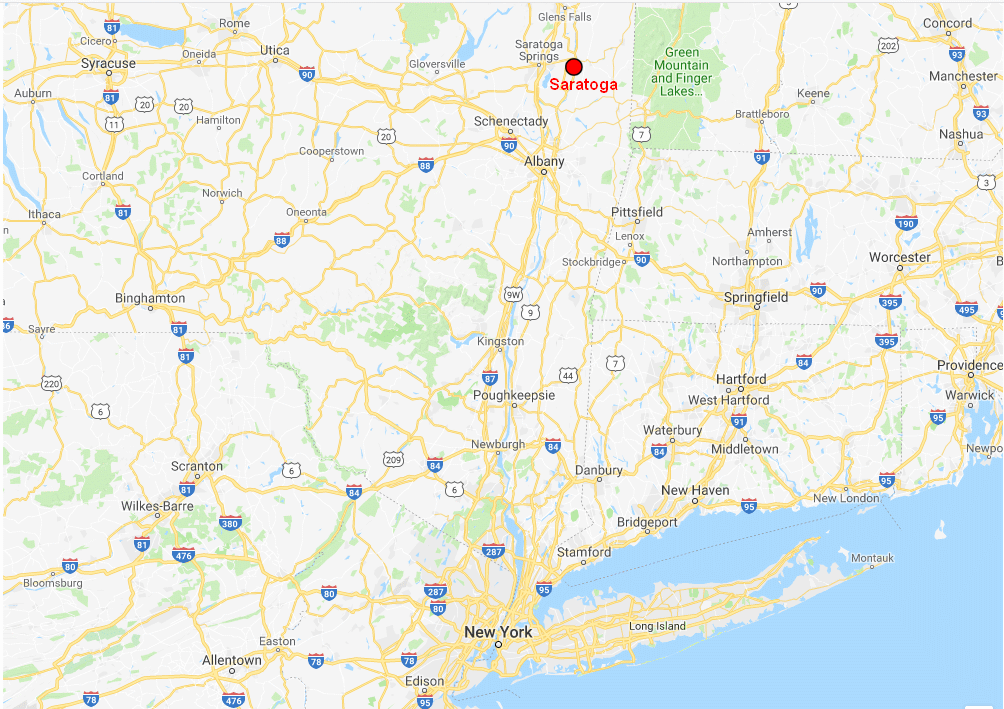 NS020351a |
141k | CV-3 was named for the Battle of Saratoga, September and October 1777. It was a decisive American victory resulting in the surrender of an entire British army of 9,000 men invading New York from Canada during the American Revolutionary War. The Battle of Saratoga was actually two battles about 9 miles south of Saratoga, New York (NS020351a), namely the Battle of Freeman's Farm and the Battle of Bemis Heights, and is related with the earlier Battle of Bennington, about 15 miles east of Saratoga. The surrender of General John Burgoyne, who was surrounded by much larger American militia forces, took place after his retreat to Saratoga. The capture of an entire British army secured the northern American states from further attacks out of Canada and prevented New England from being isolated. A major result was that France entered the conflict on behalf of the Americans, thus dramatically improving the Americans' chances in the war. The Battle of Saratoga was the turning point in the Revolutionary War. The first Battle at Saratoga, generally referred to by historians as Freeman's Farm, began with John Burgoyne's offensive (19 September)—the British lost two men for every one American casualty. In terms of ground gained, however, both sides fought to a draw. In the second Battle, otherwise known as Bemis Heights (7 October), British losses were four to one. The rebels' victory was overwhelming. After negotiations, Burgoyne officially surrendered on 17 October. He returned to England in disgrace and was never given another command. When news of the American victory reached Europe, France entered the war on the side of the patriots. Money and supplies flowed to the American cause, providing Washington's Continental Army with the support necessary to continue its fight against Great Britain. Britain's loss at Saratoga was disastrous because it showed the European powers that the rebels were capable of defeating the English on their own. More than any other event, it would prove decisive in determining the eventual outcome of the War and the victory of Patriots. American warships that had previously borne the name:
NS020351: Surrender of General Burgoyne, painting by John Trumbull (1822); photograph by the Architect of the Capitol. |
Map courtesy of Hamstermap.com. Partial
text and painting courtesy of Wikipedia. Submitted by Bill Gonyo. |
||||
 NS020351 |
205k | ||||||
| Construction |
|||||||
NS020292 |
48k | Contract design for the Lexington and the Saratoga, 1922. The oval opening right aft is for twin torpedo tubes. Line drawing by A.D. Baker, III. Drawing and text from U.S. Aircraft Carriers: An Illustrated Design History, by Norman Friedman. |
Robert Hurst | ||||
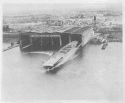 NS020352 |
191k | Launching of Saratoga at the New York Shipbuilding Corp., Camden, N.J., Tuesday, 7 April 1925. Photo by Aero Service Corp., Philadelphia, PA. (Digitally enhanced by Tom Kermen.) |
Ron Reeves | ||||
 NS020352a |
"AIRPLANE CARRIER GOES INTO THE DELAWARE. Photograph taken at Camden, N.J., yesterday, after the Saratoga had been christened by Mrs. Wilbur, wife of the Secretary of the Navy. The vessel will carry 72 airplanes, has a speed of 33 knots and hour [sic], and develops 180,000 horsepower. Copyright by Miller Service." The Evening Star, Washington, D.C., Wednesday, 8 April 1925. |
Library of Congress, Chronicling America, via Michael Mohl | |||||
 NS020399 |
180k | "This is an incidental view of USS Saratoga in the wet basin slip at New York Ship, Camden NJ. The date is unspecified but between April 1925 and November 1927. In this period the Swiss Brown Boveri Corp had taken over running the business. From the Aero Service photo collection at ISM, for educational and non-commercial use." |
John Chiquoine | ||||
 NS020379 |
5.37M | 'Instructions For Operation And Maintenance, 12" DAMAGE CONTROL PUMP, Installed Aboard Aircraft Carrier, CV-3 U.S.S. Saratoga' The date would be 'as commissioned.' |
Ed Zajkowski | ||||
| The Pre-War Years |
|||||||
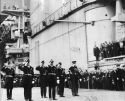 NS0203bc |
128k | This appears to be the commissioning ceremony of USS Saratoga (CV-3), 16 November 1927. Temple University Libraries, George D. McDowell Philadelphia Evening Bulletin photographs. |
Via Michael Mohl | ||||
 NS020382 |
151k | A Chance Vought UO-1 piloted by LCDR Marc Mitscher makes the first landing aboard the aircraft carrier USS Saratoga (CV-3). The fore-and-aft arresting wires were engaged by a "comb" between the aircraft's wheels. The "fiddle bridges" held the wires off the flight deck. Athwartship wires which were snagged by an arresting hook on the aircraft were in simultaneous use. The fore-and-aft wires were soon abandoned. U.S.Navy photo. |
Robert Hurst | ||||
 NS0203bk |
415k | A view of the 5"/25 anti-aircraft guns, port forward, on the U.S. Navy aircraft carrier USS Saratoga (CV-3), circa 1927. National Naval Aviation Museum photo, # 1989.119.002. |
John Spivey | ||||
 NS020321 |
99k | Painting by Walter L. Greene, 1927, depicting the ship launching aircraft. Courtesy of the Navy Art Collection, Washington, DC. U.S. Naval Historical Center Photograph (# NH 42486-KN). |
Michael Mohl | ||||
 NS0203ab |
67k | "Airplane Carrier Saratoga." Edward Shenton American Aviation Art, Vintage Art Deco Graphic Art, Illustration Print, 1928. |
Tommy Trampp | ||||
 NS020331 |
120k | USS Saratoga, probably in January 1928, at the Philadelphia Navy Yard. |
Jack Treutle | ||||
 NS0203bm |
189k | Tugs ease Saratoga (CV-3) down the Delaware River to the Navy drydock. National Naval Aviation Museum, photo # 1996.488.011.007. |
Mike Green | ||||
 NS0203ai |
61k | Stern view of USS Saratoga (CV-3), anchored near the Norfolk Naval Operating Base after completing her first sea trials on 6 January 1928. She stayed in Norfolk for two days to take on naval stores and ammunition. Photo courtesy of the Norfolk Public Library. |
Bill Gonyo | ||||
 NS020303 |
114k | This ship is in fact Saratoga (CV-3), early in her career. |
Manuel D. Tafoya, Sr. | ||||
 NS020316 |
35k | USS Saratoga (CV-3) at anchor in the late 1920s. |
Ron Reeves | ||||
 NS020353 |
247k | USS Los Angeles (ZR-3) landing on USS Saratoga (CV-3), 27 January 1928. Note lines used to walk the airship forward from the aircraft carrier's stern. U.S. Naval History and Heritage Command Photograph, # NH 44097. |
Paul Rebold | ||||
 NS02990303 |
79k | USS Los Angeles (ZR-3) landing on USS Saratoga (CV-3), 27 January 1928. U.S. Naval History & Heritage Command photograph (# NH 63067). |
Naval History & Heritage Command | ||||
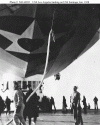 NS02990303a |
84k | USS Los Angeles (ZR-3) on the after flight deck of USS Saratoga (CV-3), 27 January 1928, after she had landed on board the carrier. U.S. Naval History & Heritage Command photograph (# NH 44095). |
Naval History & Heritage Command | ||||
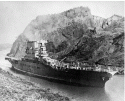 NS020313a |
164k | USS Saratoga (CV-3) in the Gaillard Cut (Culebra Cut), Panama Canal, bound for the Pacific, on the morning of 7 February 1928. (Thanks to John Fry for his help.) National Naval Aviation Museum photo, # 1996.488.011.003. |
David Buell Mike Green |
||||
 NS020313 |
51k | USS Saratoga steams through the Panama Canal, 7 February 1928. She has two floatplanes on her flight deck. Note that the outer portions of platforms for her 5"/25 guns have been folded up to clear her of the lock walls. |
From the collection of EM Gerald M. Charpentier, USN (1917-1920). Contributed by his niece, Elaine C. Witty, via Larry Bohn. | ||||
 NS020313b |
44k | USS Saratoga steams through the Panama Canal, probably on the same occasion as photo NS020313, above. |
Robert Ruiter; Amsterdam, the Netherlands | ||||
 NS020313e |
79k | As above. |
Bob Canchola, BT, USN (Ret.) | ||||
 NS020313c |
161k | "USS Saratoga & HMS Despatch in Miraflores locks, Panama Canal," 7 February 1928. |
Tommy Trampp | ||||
 NS020313d |
90k | ||||||
 NS020367 |
414k | USS Lexington (CV-2), left, and USS Saratoga (CV-3), right, moored at Puget Sound Navy Yard, Bremerton, Washington, 22 September 1928. Note Sara had a walkway on the face of her stack—one of the few distinguishing features between these otherwise nearly identical twins. She did not have her distinctive black stripe on the funnel yet. This was added after their first Fleet Problem participation in January 1929.
|
Robert M. Cieri Darren Large |
||||
 NS020366 |
49k | USS Saratoga (CV-3) underway circa 1928. Appearance characteristics at this time included the very wide funnel and the four 8in/55 LA guns in twin mounts on the starboard side of the flight deck. Note also the light-coloured awnings for the groups of three 5in/25 AA guns. | Robert Hurst | ||||
 NS0203ar |
263k | USS Saratoga (CV-3) prewar. Location and date unknwon. | Bob Canchola, BT, USN (Ret.) | ||||
 NS020394 |
128k | A U.S. Navy Boeing F2B-1 (A-7440) belonging to Fighting Squadron VF-1B based aboard the aircraft carrier USS Saratoga (CV-3), circa 1928. Note the unit's "High Hat" insignia below the cockpit. USN photo. Scanned from United States Navy and Marine Corps Fighters 1918–1962, compiled by Paul R. Matt and edited by Bruce Robertson. |
Robert Hurst | ||||
 NS020337 |
52k | Aerial view of USS Saratoga (CV-3), probably in 1929, location unknown. |
Robert Hurst | ||||
 NS020354 |
211k | A Torpedo and Bombing Squadron TWO B (VT-2B) T4M-1 making an approach on USS Saratoga (CV-3), 1929. Note the squadron's dragon insignia on the fuselage just aft of the lower wing. |
Scott Ridlon | ||||
 NS0203bj |
657k | Famous aviator Charles A. Lindbergh arrived aboard USS Saratoga (CV-3) on 8 February 1929 and spent two days observing operations. He was invited to fly the new F3B-1, as an honorary member of VB-2B squadron. NS0203bj: Lindbergh poses in F3B-1 2-B-1, designating number A-7739, the personal mount of VB-2B skipper LCDR Arthur C. Davis. Note the "Felix the Cat" squadron emblem and the "Flying Turtle," indicating that this aircraft had flown across the equator. San Diego Air & Space Museum photo, PictionID: 38279301, Catalog:AL-135A 061. Photo donated to the Museum by Chief Photographer's Mate John Lee Highfill. NS0203bja: National Naval Aviation Museum photo, # 1989.119.002. NS0203bjb: San Diego Air & Space Museum photo, PictionID: 38489791. NS0203bjc: San Diego Air & Space Museum photo, BIOL00078. NS0203bjf: San Diego Air & Space Museum photo, BIOL00250. NS0203bjg: San Diego Air & Space Museum photo, BIOL00256. |
Bob Canchola, BT, USN (Ret.) | ||||
 NS0203bja |
320k | ||||||
 NS0203bjb |
756k | ||||||
 NS0203bjc |
971k | ||||||
 NS0203bjf |
554k | ||||||
 NS0203bjg |
272k | ||||||
 NS0203bjd |
579k | Left to right: LT(JG) William V. Davis, Jr.; Charles A. Lindbergh; LT(JG) Aaron P. Storrs; and LCDR Arthur C. Davis. NS0203bjd: Naval History and Heritage Command photo, # NH 94860. NS0203bje: San Diego Air & Space Museum photo, # BIOL00257. |
Bob Canchola, BT, USN (Ret.) | ||||
 NS0203bje |
318k | ||||||
 NS0203aq |
172k | Stunt Fliers of Squadron VF-1B photographed on 16 August 1929, posed in front of a Boeing F2B-1 fighter plane. VF-1B was assigned to USS Saratoga (CV-3). Those present are Lieutenant (Junior Grade) Frank C. Sutton, USN; Lieutenant Leslie E. Gehres, USN; Lieutenant Jackson R. Tate, USN; Lieutenant (Junior Grade) George T. Mundorff, Jr., USN; Lieutenant (Junior Grade) Creighton K. Lankford, USN; Lieutenant (Junior Grade) Frank O'Beirne, USN; Lieutenant (Junior Grade) Frederick N. Kivette, USN; Ensign William H. McMullen, USNR; Lieutenant (Junior Grade) Clarence Wade McClusky, Jr., USN. Official U.S. Navy Photograph, now in the collections of the U.S. National Archives and Records Administration (NARA), 80-G-425912. |
Courtesy of Scott Koen & ussnewyork.com | ||||
 NS020210 |
192k | USS Lexington (CV-2), top; USS Saratoga (CV-3); and USS Langley (CV-1), accross the pier from Saratoga. Bremerton, Washington, 11 November 1929. This is one of the earliest known photos of Saratoga with her distinctive funnel stripe. |
From the collection of Joseph P. English. Contributed by his son, George E. English. | ||||
 NS020210a |
1.34M | As above, cropped. |
Bob Canchola, BT, USN (Ret.) Robert Hurst. |
||||
 NS0203bh |
491k | The Navy's first three aircraft carriers docked at the Puget Sound Navy Yard, Bremerton, Washington, circa 1930 (approximately at the same time as the photo above). Ships are, from front: USS Langley (CV-1), USS Saratoga (CV-3), and USS Lexington (CV-2). Courtesy of Chief Photographer John L. Highfill, USN ret. Naval History & Heritage Command photo, # NH 95037 |
John Spivey | ||||
 NS0203al |
501k | USS Saratoga (CV-3) entering San Francisco Bay, 18 December 1929. National Archives and Records Administration (NARA) photo, id. 23935571. |
David Upton | ||||
 NS0203bd |
73k | USS Saratoga (CV-3) coming into dock, Puget Sound Navy Yard, Washington, 17 November 1930. This photo documents the extension to Dry Dock No. 2. National Archives and Records Administration (NARA) photo, id. 299629. Record Group 181, NAIL Control Number NRIS-181-PSNSHISTPHO-685. |
NARA, via Michael Mohl |
||||
 NS020304 |
61k | Undated, underway with aircraft on deck. | USN | ||||
 NS020320 |
139k | At anchor, date and place unknown. | Michael Donegan | ||||
 NS020315 |
336k | Undated, pre-war photo of USS Saratoga (CV-3) off Ballast Point, Point Loma, California. |
Mike Brock | ||||
 NS0203ap |
562k | USS Saratoga (CV-3) underway, launching aircraft, circa 1929. This carrier is sometimes identified as USS Lexington (CV-2). However, the shape of the radio compass booth, suspended from the underside of the lower top, identifies her as Saratoga. |
Curt Molten, grandson of CAPT Robert P. Molten, Saratoga's CO in 1940 |
||||
 NS020322 |
141k | Aircraft on the flight deck, preparing for launching, circa 1929-30. Planes in the foreground are Boeing F3B-1 fighters [of VB-2B squadron]. In the background are fifteen Martin T4M-1 torpedo planes, of Torpedo Squadron Two (VT-2B). Courtesy of the Naval Historical Foundation, Washington, D.C. Collection of Admiral William V. Pratt. U.S. Naval Historical Center Photograph (# NH 75874). Note: This photo may have been taken in early 1929, during Fleet Problem IX. In any event, it can't have been taken later than September 1929: the foremost T4M is sitting on the "fiddle bridge" arresting gear, which was removed from Saratoga in said month. The carrier had spent three months (June-August) at anchor at San Pedro, without any aircraft. Sources: Tracy White, Researcher @ Large; John Fry, USS Saratoga CV-3, pages 29–36. |
NHC | ||||
 NS0203au |
116k | Sara's massive stack, flight deck and island structure views, circa 1929–1931. |
Collection of RADM Theodore R. Frederick, via Edwin Kaukali |
||||
 NS020323 |
391k | Vought O2U-2 Corsair aircraft, of Marine Corps Scouting Squadron 14 (VS-14M) fly past USS Saratoga (CV-3) while preparing to land on board, circa 1930. Note Marine Corps insignia painted under the after cockpit of the closest aircraft. Courtesy of PHC John L. Highfill, USN (Retired). Naval History & Heritage Command (NH&HC) Photograph (# NH 94899). |
NH&HC, via Bob Canchola, BT, USN (Ret.) |
||||
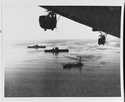 NS020243 |
543k | USS Los Angeles (ZR-3) flies over ships of the U.S. Fleet, circa 1930. Photographed from on board the airship, with two of her engine cars in the foreground. Ships below are USS Patoka (AO-9), closest to the camera, and the aircraft carriers USS Lexington (CV-2) and USS Saratoga (CV-3). Official U.S. Navy Photograph, now in the collections of the National Archives (# 80-G-462136). |
Hampton Roads Naval Museum | ||||
 NS020339 |
61k | USS Saratoga (CV-3) at anchor circa 1930, location unknown. |
Robert Hurst | ||||
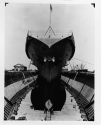 NS020327 |
331k | USS Saratoga (CV-3) in drydock at Hunter's Point, San Francisco, California, circa the early 1930s. (The S.S. Mexican is in the right distance. She was USS Mexican (ID # 1655) in 1917–1919.) Courtesy of PHC John Highfill, USN (Retired). U.S. Naval Historical Center Photograph (# NH 94849). |
Michael Mohl Darryl Baker |
||||
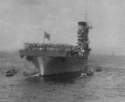 NS020329 |
31k | USS Saratoga (CV-3) anchored, most likely, at San Diego, early 1930s. Photo by Teddy Krueger, USS Holland (AS-3). |
Rick Larson, MMCM(SS) ret. | ||||
 NS020318 |
47k | Flight deck scene, 1930s. |
Photo by Robert Bressan | ||||
 NS0203ax |
66k | "U.S. Aeroplane Carrier Saratoga," 1931. Gouache on paper painting by noted marine painter Worden Wood (1880–1943). |
Via Michael Mohl | ||||
NS020340 |
98k | A painting of USS Saratoga (CV-3) underway in the 1930s, made by Michael Donegan for Trumpeter models. |
Michael Donegan, NAVYDAZE | ||||
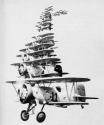 NS020386 |
65k | A flight of 17 U.S. Marine Corps Boeing F4B-4 fighters of Marine Fighter Squadron VF-9M assigned to USS Saratoga (CV-3) in the early 1930s. The squadron was later redesignated VMF-111. U.S. Navy Naval Aviation News, October 1981 issue. |
Robert Hurst | ||||
 NS0203ad |
354k | Two views of USS Saratoga (CV-3), early-to-mid 1930s. |
Photos by CWO4 Cecil Wood USMC, contributed by his son Donald Wood | ||||
 NS0203ada |
120k | ||||||
 NS0203bl |
363k | USS Saratoga (CV-3), date (circa 1930s) and location unknown. Photo by George Winstead, # 235 |
Terry Heggy | ||||
 NS0203bn |
262k | With a flying boat overhead, USS Saratoga (CV-3) emerges from a smoke screen during fleet exercises in the 1930s (1932?). National Naval Aviation Museum photo, # 1994.103.017.004. |
Pieter Bakels Mike Green |
||||
 NS0203az |
2.44M | USS Saratoga (CV-3) in San Diego Bay, California, circa the first half of the 1930s. Note USS Langley (CV-1) and USS Wright (?) (AV-1) in the background, moored at Naval Air Station San Diego (North Island). Courtesy of the San Diego Air & Space Museum, Catalog # SHIPS01376. |
Via Bob Canchola, BT, USN (Ret.) | ||||
NS020317 |
50k | A Boeing F4B-4 of Fighting Squadron 6 (VF-6B) departs from the flight deck of the carrier USS Saratoga. Photo taken sometime between June 1931 and June 1933. Photo courtesy of the Boeing Airplane Company. |
Robert Hurst | ||||
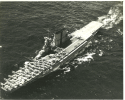 NS020387 |
195k | USS Saratoga (CV-3) recovering her planes off Maui, Hawaii, 2 March 1932. National Archives and Records Administration (NARA) photo, #80-G-466400. |
Robert M. Cieri | ||||
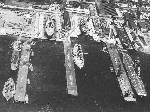 NS013818a |
134k | Puget Sound, possibly in the second quarter of 1932, shortly before photo below. Identifiable ships in this photo are, from left to right: U.S. Crane Ship No. 1, ex-Kearsarge (BB-5); seaplane tender Jason (AV-2); one of the Colorado-class battleships, possibly the West Virginia (BB-48), in the dry dock; and a Pennsylvania-class battleship along the pier. The aircraft carrier in the photo is USS Saratoga (CV-3) — note the "SARA" on the flight deck aft. |
USN Photo courtesy of Pieter Bakels. Photo & partial text id. courtesy of Chris Hoehn & David C. Nilsen With additional information from David Stubblebine. |
||||
 NS0403432 |
1.26M | Puget Sound Navy Yard, Bremerton, Washington. The aircraft carriers USS Lexington (CV-2) and USS Saratoga (CV-3) at the yard. Photo appears to be dated 8 June 1932, but Saratoga was in Dry Dock #2 on that date. Also present is USS Jason (AV-2), an old collier converted into a seaplane tender, at left. The future USS Astoria (CA-34) is under construction in drydock, upper right. Photographed from a USAAC plane. (Thanks to David Stubblebine for providing additional information.) Naval History & Heritage Command (NHHC) photo (# NH 93556). |
NHHC, via Tom Bateman | ||||
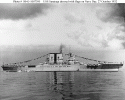 NS020324 |
98k | USS Saratoga (CV-3) dressed with flags on Navy Day, 27 October 1932. Official U.S. Navy Photograph, now in the collections of the National Archives (# 80-G-1007395). |
NHC | ||||
 NS0203ao |
386k | USS Saratoga (CV-3) crossing the Panama Canal, pre-1933. Photos from the souvenir album of Pvt. Walter Fish, stationed at Ft. Amador. |
Steve Hatchett | ||||
 NS0203aoa |
277k | ||||||
 NS0203aob |
340k | ||||||
 NS0203bg |
180k | Three U.S. Navy Curtiss BFC-2 Goshawk fighters assigned to Fighting Squadron (VF) 2B in the 1930s. The squadron was redesignated from VF-1B to VF-2B and then to VF-3B and was the only one which operated the BFC-2, from February 1933 to February 1938. It was based aboard the aircraft carrier USS Saratoga (CV-3). U.S. Navy Commander, Naval Air Forces Centennial of Naval Aviation website. |
Robert Hurst | ||||
 NS020159 |
194k | Ships of the United States Fleet pictured at anchor inside the breakwater at Colon, Canal Zone, 1933. Identifiable ships include the aircraft carriers Lexington (CV-2), Langley (CV-1), and Saratoga (CV-3), as well as the battleships Texas (BB-35) and New York (BB-34). Omaha-class and Pensacola-class cruisers are also visible. National Naval Aviation Museum (NNAM) photo (# 1996.488.001.006). |
NNAM | ||||
 NS020205 |
166k | USS Saratoga (CV-3) and USS Lexington (CV-2) in front of Diamond Head. Regardless of what is printed on the picture, it must have been taken after 1933, when Saratoga's bridge was modified. [On July 1, 1932 Sara was berthed at Pier 6, Bremerton, WA.] |
Geoff Bell | ||||
 NS0203be |
544k | USS Saratoga (CV-3). Photo possibly taken at the same time as the photo above. "Chief Carpenters Mate Alvin (Pappy) Caldwell, joined the Navy in 1937. Following his training, he was assigned to the Pacific and served short tours on both the USS Saratoga and USS Lexington. Both of these assignments were before the war started. He subsequently was assigned to the USS Fulton submarine tender and was the first ship's company and a Plankowner on the USS Fulton. He remained in the Navy through all of World War II completing his service as a Chief Carpenters Mate. [This photo and NS020341c] were in a frame Dad made during the war from wood recovered from battle-damaged ships." |
Peter B. Caldwell, LCDR, USN (Ret.), for his father, Chief Carpenters Mate Alvin ("Pappy") Caldwell |
||||
 NS020301b |
127k | USS Saratoga (CV-3) steams north for the Presidential Review, 31 May 1934. The "Crowing Cock" emblem can be seen on the stack stripe. National Museum of the U.S. Navy photo (Lot-854-5). |
Courtesy of the National Museum of the U.S. Navy, via Michael Mohl | ||||
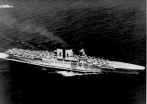 NS020301 |
215k | Sara's aircraft prepare to take off during a Presidential Review by President Roosevelt, off New York City, May 31, 1934. As President Roosevelt watched from USS Indianapolis (CA-35), 90 ships passed by, led by USS Pennsylvania (BB-38) flying the 4-star flag of Admiral Sellers. Note one of Saratoga's two destroyer plane guards (upper left corner). Image # 80-G-462893. |
National Archives | ||||
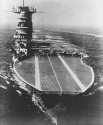 NS020301a |
89k | Sara prepares to pass in review for President Franklin D. Roosevelt, 31 May 1934 (see NS020301). (Thanks to John Fry for dating the photo). Photo from NARA, San Francisco. |
Tracy White, Researcher @ Large | ||||
 NS020332 |
134k | Believed to have been taken off New York City. If this is correct, this photo must have been taken in May-June 1934 — there was a Presidential Review on May 31, see above. |
Rich Delaney | ||||
 NS020350 |
105k | USS Lexington (CV-2), left, and USS Saratoga (CV-3) open to the public for viewing at New York City, June 1934. |
Photo from the collection of Edmund Cokely WO2, USN (Ret.) Submitted by his son-in-law, John Dupre' | ||||
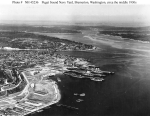 NS010558 |
112k | Puget Sound Navy Yard, Bremerton, Washington. Aerial photograph taken in the mid-1930s. Alongside the pier in center are the aircraft tender (ex-collier) Jason (AV-2), laid up in 1932 and sold in 1936, and the crane ship Kearsarge. Also present are the aircraft carriers Lexington (CV-2) and Saratoga (CV-3), the latter with her distinctive funnel stripe. U.S. Naval Historical Center Photograph (# NH 45236). |
NHC | ||||
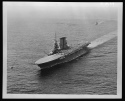 NS020349 |
578k | Launching biplanes, circa the mid-1930s. |
Ron Titus Ron Reeves |
||||
|
|||||||
 NS020310 |
149k | USS Saratoga (CV-3) landing planes on 6 June 1935. Official U.S. Navy Photograph, now in the collections of the National Archives (photo # 80-G-651292). |
Scott Dyben | ||||
NS020335 |
44k | USS Saratoga (CV-3) underway circa 1936, location unknown. |
Robert Hurst | ||||
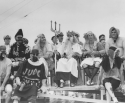 NS020391 |
109k | "King Neptune and his Party hold court aboard CV-3 Saratoga on May 20, 1936. This visit of His Majesty Neptunus Rex saw one of the largest single group of pollywogs to be initiated to date, including the Vice Admiral Henry Varnum Butler, who had yet to cross the equator in 45 years of Naval service." National Archives photo (# 80-G-188724). |
Tracy White, Researcher @ Large |
||||
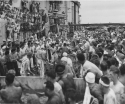 NS020391a |
188k | "Pollywogs undergoing initiation on the flight deck of Saratoga. Medical personnel were reportedly sent before King Neptune first, so they could staff the ship's hospital for the rest of the crew. Satatoga's Captain, William 'Bull' Halsey, saw to it that one of Saratoga's Pollywog ensigns who had aided a 'mutiny' of pollywogs received 'a helluva beating' during his initiation but kept his record clear of charges. That officer later earned two silver stars during World War Two and commanded nine submarine patrols against the Japanese." National Archives photo (# 80-G-188725). |
|||||
 NS020377 |
38k | USS Saratoga (CV-3) and three battleships at anchor, San Francisco Bay, most likely on the occasion of the inauguration of the San Francisco-Oakland Bay Bridge, November 1936. |
Ron Reeves | ||||
 NS020381 |
229k | Grumman J2F-1 Duck, BuNo 0174, number 4 plane of the USS Saratoga (CV-3) Utility Unit, circa 1936–1940. |
Brad Proffitt, for his father Floyd Proffitt, USS Thresher (SS-200) | ||||
 NS020341 |
115k | Left to right: USS Saratoga (CV-3), USS Lexington (CV-2) and USS Ranger (CV-4) off Honolulu, with Diamond Head in the background. This picture was probably taken in April 1938, during Fleet Problem XIX. |
Photo from the collection of Edmund Cokely WO2, USN (Ret.) Submitted by his son-in-law, John Dupre' |
||||
 NS020341a |
41k | NS020341a: Left to right: USS Ranger (CV-4), USS Lexington (CV-2), and USS Saratoga (CV-3). NS020341b: Saratoga. Photos taken by Roger's grandfather, probably in April 1938, at about the same time as the photo above. |
Roger Reynolds | ||||
 NS020341b |
49k | ||||||
 NS020341c |
435k | Foreground to background: USS Saratoga (CV-3), USS Lexington (CV-2) and USS Ranger (CV-4), possibly on the same occasion as photos above. |
Peter B. Caldwell, LCDR, USN (Ret.), for his father, Chief Carpenters Mate Alvin ("Pappy") Caldwell (See also NS0203be.) |
||||
 NS020342 |
214k | USS Saratoga (CV-3) underway, seemingly heading north after leaving San Diego. She was awarded the large "E," for Engineering Excellence, for the first time on August 16, 1938. The photo must have been taken before August 1939, when Sara was awarded a second "E," denoted by a hashmark under the giant "E" on her stack. (USN photo.) (Please disregard what is printed on the photo.) |
Ron Titus | ||||
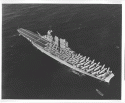 NS020369 |
84k | USS Saratoga (CV-3) sometime between mid-1938 and mid-1939 (note single Engineering Excellence "E" on her stack). |
Paul Rebold | ||||
 NS0203aj |
312k | USS Saratoga (CV-3) sometime between mid-1938 and mid-1939. Possibly second half of 1938, in Californian waters. Photographed by Geo. Winstead. |
Courtesy of Jim Kurrasch, Battleship Iowa, Pacific Battleship Center | ||||
 NS020384 |
430k | USS Saratoga (CV-3) passing under the Golden Gate Bridge, San Francisco. Date may be January 1939. |
Mike Brock | ||||
 NS09120129 |
229k | USS Relief (AH-1) and USS Saratoga (CV-3)—background—at anchor off one of the Hawaiian Islands, circa summer of 1939–summer 1940. |
Brad Proffitt, for his father Floyd Proffitt, USS Thresher (SS-200) | ||||
 NS020375 |
167k | This tobacco card was issued by John Player & Sons in the U.K. in 1939 and came from a series entitled "Modern Naval Craft." |
Tommy Trampp | ||||
 NS020375a |
163k | ||||||
 NS020380 |
34k | USS Saratoga (CV-3) at anchor. Location is believed to be Hawaii. Date is unknown, but may be late 1930s–early 1940s. | Tommy Trampp | ||||
 NS020306 |
54k | USS Saratoga (CV-3) at anchor, 1939–1940 (note hashmark in lieu of a second Engineering "E.") Good view of her forward twin 8" mounts. | USN | ||||
 NS020338 |
65k | Brewster F2A-1 Buffalo, Bureau Number 1393, after LT John Smith "Jimmy" Thach tipped the aircraft onto its nose on the Saratoga's deck, 11 March 1940. Ensign Edward Butch O'Hare also flew this aircraft several times during the summer and fall of 1940. Photo source unknown. |
Robert Hurst | ||||
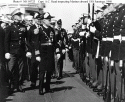 NS020325 |
105k | Captain Albert C. Read, USN, Commanding Officer, USS Saratoga (CV-3) inspects the ship's Marines during change of command ceremonies, 15 March 1940. Captain Robert P. Molten, USN, the new CO, is visible over Read's right shoulder, also wearing a "fore and aft" hat. Collection of Vice Admiral Dixwell Ketcham, USN. U.S. Naval Historical Center Photograph (# NH 95723). |
NHC | ||||
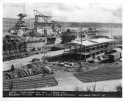 NS0203ba |
358k | "THE END OF THE BLACK STRIPE—A rare and fascinating view of USS Saratoga (CV-3) in the newly built Dry Dock #4 at Puget Sound Naval Shipyard on March 3, 1941." "You can see the yard workers in the process of painting out the famous black stripe that had been there since 1929 to distinguish her from her near identical sister, USS Lexington (CV-2)." "From 6 January to 28 April 1941, Saratoga underwent a long-deferred modernization at the Bremerton Navy Yard that included the widening of her flight deck at her bow and the installation of additional antiaircraft guns and a CXAM-1 radar." ("338-41. Puget Sound Navy Yard. 3 March 1941. Equipment building. General view, looking Southeast. Allotment 17X1227 047") |
Darren Large | ||||
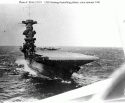 NS020355 |
79k | USS Saratoga (CV-3) launching planes, circa summer 1941, as seen from the rear cockpit of a plane that has just taken off. Aircraft on deck are Douglas TBD-1 Devastator torpedo planes, probably from squadron VT-3. Official U.S. Navy Photograph, now in the collections of the National Archives (# 80-G-21191). |
Paul Rebold | ||||
 NS0202az |
3.15M | "LATEST OFFICIAL PICTURES OF OUR NAVY IN ACTION" "America's First Line of Defense As Streamlined As It Is Alert" "Navy pilots can hold position in formation flying with wings almost touching wings. Each plane, in 'tight' formations, is a protection to its neighbors. These planes are Vought-Sikorsky dive bombers from the Saratoga." Detroit Sunday Times Pictorial Review, Sunday, 10 August 1941. |
Library of Congress, Chronicling America, via Michael Mohl | ||||
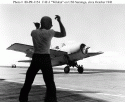 NS020378 |
65k | A Grumman F4F-3 Wildcat of Fighting Squadron Three (VF-3) prepares to take off from USS Saratoga (CV-3), circa October 1941. The plane's pilot is probably LT John S. Thach, VF-3 Commanding Officer. Photograph from Department of the Navy collections in the U.S. National Archives (# 80-PR-1154). |
Robert Hurst | ||||
 NS020356 |
96k | Grumman F4F-3 Wildcat fighters, of Fighting Squadron Three (VF-3), on board USS Saratoga (CV-3) in early October 1941. Plane on the aircraft elevator is BuNo 3982 (3-F-9, later 3-F-15), piloted by Ensign Gayle Hermann. U.S. Naval Historical Center Photograph (# NH 97485). |
Paul Rebold. Some caption details are taken from John B. Lundstrom's "The First Team." |
||||
| Memorabilia |
|||||||
 NS0203ah |
550k | "The U.S.S. Saratoga, airplane carrier, at anchor in the harbor, San Diego, California." Undated postcard. |
Arnold Putnam | ||||
 NS0203bo |
1.00M | Four pages from the Cruise of the U.S.S. Saratoga, 1936. |
Antonio Peinado Romero | ||||
 NS020334 |
246k | USS Saratoga, "The Ship of Happy Landings," Christmas Menu, 1936. Long Beach, California. Commanding Officer was Captain William F. Halsey, Jr. Later, he was Commander, Third Fleet in the advance across the Pacific during World War II, and attained the rank of Fleet Admiral (the fourth and last officer to hold that rank). Executive Officer was Commander Frederick C. Sherman. A renowned leader of carrier task groups during World War II, he was awarded three Navy Crosses and attained the rank of Vice Admiral. |
Robert M. Cieri | ||||
 NS020334a |
170k | ||||||
 NS020334b |
165k | ||||||
 NS020334c |
11k | Judith Kirkland Qualm, daughter of Frederick B. Kirkland, USMC |
|||||
 NS020334d |
101k | Christmas Church Service, 1936. |
Judith Kirkland Qualm, daughter of Frederick B. Kirkland, USMC |
||||
 NS020334e |
90k | ||||||
 NS020365 |
66k | Frederick B. Kirkland, aboard USS Saratoga (CV-3), was appointed a Private First Class in the United States Marine Corps on 4 January 1938. NS020365: Note signature of Captain John H. Towers. NS020365a: Note signature of Captain Albert C. Read. |
Judith Kirkland Qualm, daughter of Frederick B. Kirkland, USMC |
||||
 NS020365a |
135k | ||||||
 NS020372 |
91k | Grand March Skate, December 1936. |
Judith Kirkland Qualm, daughter of Frederick B. Kirkland, USMC |
||||
 NS020372a |
92k | ||||||
 NS020364 |
105k | Ship's Bell, displayed at the National Naval Aviation Museum, Pensacola, Florida. |
Photo by Judson Phillips (13 June 2008) | ||||
 NS020364a |
40k | Photo by Joseph Pires (28 February 2016) | |||||
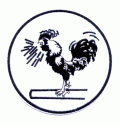 NS020374 |
157k | Ship's Patch. |
Courtesy of Don McGrogan, BMCS, USN Ret. | ||||
 NS020388 |
42.6M | Sara: The Story of the U.S.S. Saratoga. |
Bruce Williams, In Memory of Al "Buddy" Williams, QM-3, CV-3 |
||||
 NS020393 |
333k | Victory Dinner menu, 15 August 1945. |
Bruce Williams, In Memory of Al "Buddy" Williams, QM-3, CV-3 |
||||
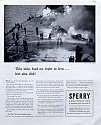 NS020392 |
79k | 1945 Vintage Ad: Sperry Corp. Gyroscope, US Navy WWII Aircraft Carrier Saratoga. |
Tommy Trampp | ||||
 NS0203ac |
60k | Halyard Keeper, USS Saratoga (CV-3), 1933. James M. Clark enlisted in the Navy in 1929. He was a Radioman, RM3, and his first ship was Saratoga. He served aboard Sara from January 1930 until September 1935 (or maybe 1939, this is not clear). |
David Park, great-nephew of James M. Clark | ||||
 NS0203aca |
29k | ||||||
 NS0203acb |
87k | ||||||
 NS0203acc |
50k | ||||||
| Sara in the Movies |
|||||||
 NS020300 |
149k | Hell Divers is a Metro-Goldwin-Mayer film released in 1932, directed and produced by George Hill, with Wallace Beery, Clark Gable, Conrad Nagel, Dorothy Jordan, Marjorie Rambeau, and Marie Prevost. It contains real footage shot aboard Saratoga, and some film frames were censored by inserting black bars at the bottom, to hide details of the arresting hooks and wires—at the time, they represented cutting-edge naval aviation technology. VF-1B "High Hatters" pilots "doubled" for the actors in the flying scenes. NS020300: Theatrical release poster. NS020300a: Actor Conrad Nagel (left) and LT(JG) Herbert S. Duckworth, John's father. NS020300c: LT(JG) Edward P. "Bud" Southwick (left) and actor Wallace Beery (right, facing camera). NS020300d: (Left to right) Actor Clark Gable, LT(JG) "Jimmy" Thach, and John's mom. NS020300e: LT(JG) Edward P. Southwick (left) and actor Wallace Beery. Note the VF-1B "High Hatters" squadron insignia. NS020300f: (Left to right) Actor Cliff Edwards; LT(JG) John S. "Jimmy" Thach, later ADM; actor Clark Gable; actor (and USNR officer) Wallace Beery; LT(JG) Herbert S. Duckworth, later VADM; and LT(JG) Edward P. "Bud" Southwick, later RADM. They are standing by a Curtiss F8C-4 Helldiver aircraft of Fighting Squadron 1B, at Naval Air Station, North Island, California, 16 September 1931. |
Wikipedia | ||||
 NS020300a |
146k | John Duckworth, son of VADM Herbert S. Duckworth | |||||
 NS020300b |
282k | ||||||
 NS020300c |
184k | ||||||
 NS020300d |
135k | John Duckworth, son of VADM Herbert S. Duckworth | |||||
 NS020300e |
119k | ||||||
 NS020300f |
190k | ||||||
|
|||||||
| Crew Contact and Reunion Information | ||||||||||||||||
|
| Related Links |
|
Hazegray & Underway World Aircraft Carrier Pages By Andrew Toppan USS Saratoga Association web site USS Saratoga (CV-3) by John Fry Operation Crossroads: Bikini Atoll, US Naval History & Heritage Command website The First Aircraft Carriers Part One: The First American Flattops- Langley, Lexington and Saratoga, an article by Father Steve Dundas |
| Main Photo Index |
Aircraft Carrier Photo Index Page |
Comments, Suggestions or Image submissions, E-mail Carrier Information
Problems and site related matters, E-mail Webmaster
This page was created by Timothy Dike and is maintained by Fabio Peña
![]()
Last update: 18 February 2025